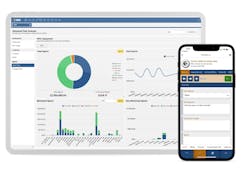What are the battery levels on specific electric ground support equipment (GSE) unit? When will the battery need to be charged? When will GSE need to be maintained or replaced? Is there enough GSE or are there too many pieces of equipment at a gate? Is there enough ground personnel? What do aircraft turnaround times look like in real-time? If a flight is delayed, who’s responsible and where was the delay?
To help answer these questions, ground service providers of varying sizes are using asset management technology.
“Asset management at the most basic level is the process of tracking, maintaining, upgrading and retiring operational assets over the course of their respective lifecycles,” says Santosh Nachu, general manger of EBIS software at Tronair.
“EAM [Enterprise Asset Management] systems enable the collection of various measures and management of the aforementioned processes through modules such as maintenance tracking, work order management, warranty management, inventory management, etc.”
Optimization is the desired outcome of any well-run asset management program, says Nachu. For instance, how many GSE assets of a certain type are needed to minimize total cost of ownership (TCO), while also ensuring a desired level of asset uptime and availability to serve the number of turns desired? What combination of preventative maintenance schedules, parts catalogs and labor hours spent on a piece of GSE maximizes its life, while also keeping costs below the price of acquiring new GSE?
“Asset management, in and of itself, does not deliver optimization,” Nachu says. “However, the ability to accurately and reliably collect data from various sources, both human and machine, contextualize them to generate metrics that are important to the organization; and apply industry best practices and policies to control these metrics are necessary conditions to achieve optimization.”
Nachu says optimal asset management is a journey that starts with identifying and tracking assets.
“Once a repository of assets is identified and can be updated over time, the objective may move to better understand the condition of these assets by accurately measuring various inputs such as usage, mean time between failure, labor costs, parts costs, productivity, etc.,” Nachu says. “After the right measures are accurately and reliably acquired, they can be transformed into specific metrics that become the dynamic parameters and constraints used to optimize functions such as total cost of ownership, fleet size, fleet lifecycle.”
Under the brand name XOPS, Resonate MP4 develops airport and airline ground handling solutions, including fleet (motorized and non-motorized), operations and data management systems, as well as vehicle access control.
“Generally, customers are looking to gain efficiencies either for their own benefit or their customers’ benefit,” says David Read, general manager at Resonate MP4.
Traditionally, an operations manager might review a monthly report done by multiple people gathering data. Read says that’s not as relevant today.
“People want to know in real time what’s happening,” he says. “Am I turning around 100 percent of my flights on time today? If not, where are the differences?”
Keeping a digital record of activities is becoming more the norm.
“Commercial contracts are often requiring hard evidence of SLA [service level agreement] performance,” Read says.
The benefits of digitized asset management are many.
According to Matthias Moulinier, product director for ADVEEZ, better knowledge on GSE usage and maintenance can increase the lifetime and performance of the assets, prevent accidents through better maintenance and safer driving and decrease asset depreciation by keeping vehicles working longer.
Benefits also include a safer working environment, cost savings from energy and fuel management, better and safer driver training and decreased greenhouse gas emissions.
As the turnover and aircraft rotations are increasing in most of the airports around the world, Moulinier says it is critical for ground handlers to enhance operations and safety during shifts. But most important is getting reliable data that can be used immediately to be able to be reactive during actions, he explains.
“Finding quickly the right GSE for the right gates at the right moment is critical to be efficient during perfectly timed operations,” Moulinier says. “Accurate and real-time information on the assets are crucial, particularly with last-minute changes with aircrafts.”
According to Read, common questions about asset management technology include “How does the technology help ground service providers improve their business?” and “How can the savings from those efficiencies be passed on to the airlines for whom they work?” Then, he says there are more specific requirements.
“Can you reduce how much fuel I use, or can you help me manage my green commitments/emissions, or can you improve safety? How can I get my staff and/or assets to be more efficient?” he says.
“We have some smaller, more specialized customers with less assets (vehicles, GSE and non-motorized equipment) but they require a very high level of precision, performance and consistency for the operation,” Read continues, noting examples of specialized needs may include aircraft fueling, air conditioning and catering. “Being able to digitally report in real time, record and audit precise information on the arrival and departure times from the aircraft turnaround site, as well as the exact contents delivered to the aircraft is critical for meeting contractual performance.”
Telematics and Beyond
Asset management allows fleet managers to increase asset usage and value over the time to get the best ROI. However, Moulinier explains, telematics systems, which are usually placed directly on the asset, are the hardware that connect and send critical data from an asset to a cloud or web platform.
Elements of telematics technology have been in use by some airlines and ground handlers for a decade or so, according to Read, adding use of the technology has gone beyond the basics of locating a vehicle on a map.
“Ultimately, you need to know in much more detail, down to the nearest meter or half meter where is the vehicle, who is driving it, how fast is it going – all this information in real time,” Read says.
The introduction of electric GSE has created a new demand for asset management technology.
“It’s quite easy to estimate how much fuel is in a vehicle,” Read points out. “It’s not as easy to estimate remotely and accurately how much battery is left in a vehicle.”
Today, Read sees demand for more granular enriched data than there was 5 or 10 years ago
“And 5 or 10 years ago technology just couldn’t provide that richness of data,” he notes.
Examples of sophisticated functions available that Nachu highlights include the ability to:
• Ingest telemetry data and utilize it for setting accurate maintenance schedules or determining part component life;
• Get real-time data on costs and availability of parts via direct integrations to suppliers to help streamline parts forecasting, costing and ordering;
• Visualize asset performance data or push them real time to other dashboarding tools via application programming interfaces (APIs).
ADVEEZ recently introduced new features on Localeez, its web platform. For example, to help increase safety, the mobile app includes an OSHA checklist. There is also a GSE driving score that indicates, in real time, the driving style including harsh breaks or turns, harsh accelerations or speeding.
To meet accreditation guidelines such as Airport Carbon Accreditation or achieve carbon management objectives in compliance with Paris Agreement, ADVEEZ is mapping, tracking and monitoring the main GHG emissions from motorized assets. GHG emissions reports provide NOx, CO2, HC, PM, CO emissions per division, per motorized assets on a period. Idle and working time reports to monitor the unnecessary usage of the asset motor and reduce the emissions.
Access control or speed control via geofence features are available as options.
“ADVEEZ has designed in its Localeez platform geofence zones that are active in real time,” Moulinier says. “One of them is automatically controlling the speed of the GSE and usually it is drawn around the aircraft at the gate. Reliable and real-time data allows (users) to reduce automatically the speed approaching the aircraft with a precision to the meter. At a pedestrian speed around the aircraft (5km/h), we are avoiding many GSE accidents that have happened in the past on the ground. With this technology, the working environment is definitely safer for everyone.”
About the Author
Rebecca Kanable
Assistant Editor
Rebecca Kanable, a veteran journalist, worked with Endeavor Business Media's aviation group from 2021 to 2024 as assistant editor of Airport Business, AMT and Ground Support Worldwide. She previously worked for various publications, including trade magazines and newspapers.

